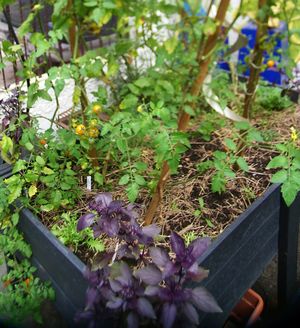
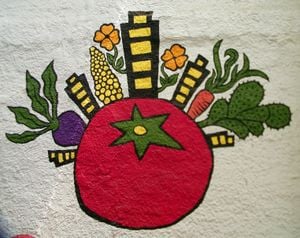
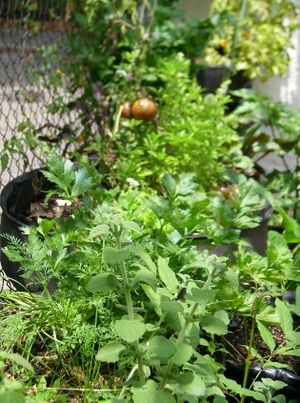
Urban soils are often either paved over and not available or they are heavily contaminated. They are also often compacted, clayey, and contain a high metal content. In response to the problems faced with poor soil available in urban spaces Sembradores Urbanos has constructed raised bed gardens. This is one project in a series of urban gardening projects at Sembradores Urbanos.
Background[edit | edit source]
Raised beds help insure that you have access to clean uncontaminated soil and they can also be a low maintenance method for composting in the place your garden will be located. The soil you add to the raised bed is one of the most important aspects of a raised bed. This soil can be created from your food scraps on site in a compost, composted manure from animals, or you could create the soil in the raised bed itself using the technique of lasagna gardening.
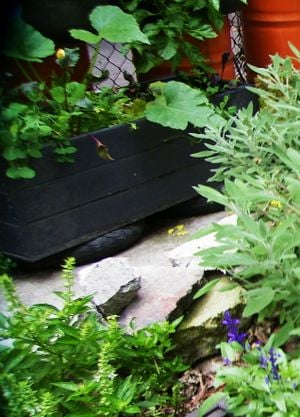
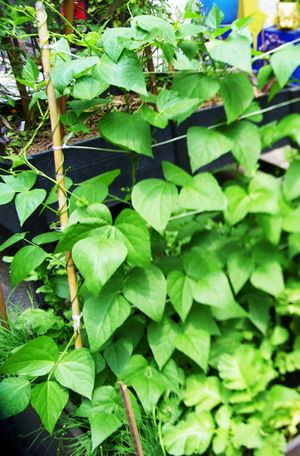
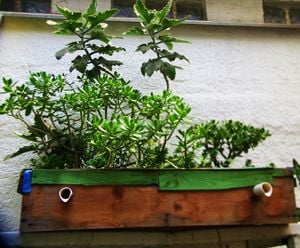
Benefits and Difficulties of a Raised Bed[edit | edit source]
Benefits[edit | edit source]
- Soil drains better, since you have added your own soil mix (like compost) and do not have the years of compaction that your lawn might have.
- Its out of reach of people and animals accidentally stepping on and compacting your garden soil.
- Easier access to plants, kneeling and crouching can be reduced.
- Soil warms more quickly in the spring, since it has direct sun on more surface area of the soil, and thus you can plant earlier.[1]
Difficulties of Raised Beds[edit | edit source]
- They require more watering, since the soil is not compacted and drains easily
- Straight sided frames may not be comfortably accessible for people in wheelchairs, requiring a slight twist and leaning of their torso.[2]
System Design[edit | edit source]
Materials for making Raised Beds[edit | edit source]
Use any available materials to contain soil in a high enough area elevated from the ground. The materials used for the container should be free of contaminants that could enter your fresh clean soil. Materials to be wary of include: pressure treated wood, railroad ties, and any woods preserved in creosote and pentachloro phenol.[3] Also choosing materials that are fairly rot resistant can lengthen the life of your raised bed. Many industrial rot resistant materials present the problem of leaching contaminants into your garden (like pressure treated wood). Other options for rot resistant materials without toxic contaminants include: redwood bark, stacked stones, bricks, adobe blocks, and cement. Since the design of raised beds is very simple and easy to make it might not be as important to have rot resistant materials.
Length, Width, and Height of Raised Beds[edit | edit source]
- Any length. Design this based on the available sun.
- Make sure your bed is not so wide that you can not comfortably reach into the center to do work without stepping into it.
- Raised beds range from unenclosed mounds that are only a few inches above the ground, to cinder block enclosed 2 ft tall beds.
Framing[edit | edit source]
- Not all raised beds have frames, some are simply made by digging up the earth into a long pile. However those without frames erode quickly and may need to be rebuilt every year. Framing also helps define your garden space, indicating to people and animals where not to walk on. Frames can also give your garden beauty, even after fall when your summer garden is gone, making landlords more likely to allow your continued gardening.
Framing Tip
- If using lumber, you can strengthen the corners of the bed by screwing in blocks at the edge of where the two pieces meet.
- Or use simple but joints, and pre-drill screws half way in to make it easier when piecing together.
Fill[edit | edit source]
- Place cardboard or newspaper on the grassy spot where your raised bed will be in order to kill any grass and its roots. If you do this at least three months before filling and planting your bed grass roots should have died and started to become a lovely addition to the humus and topsoil in your garden. This practice is a great substitute for the work involved in digging and ploughing.
- If you do not want to wait and you want to insure that your plants will not be stunted when their roots reach the ground level you should dig a few inches down. Digging disrupts important microbial activity (and thus nutrient availability) within the surface layer, or topsoil, so this practice should be minimized when possible.
Creating Your own Soil Options[edit | edit source]
- Composting. Composting relies on creating an aerobic environment, where available oxygen oxidizes carbon and allows for bacteria and other microorganism growth, which can help break down the materials in your compost. Compost can be made out of food scraps, yard waste or animal manures.
- Lasagna Gardening. Is a low maintenance soil creation process that relies on similar elements to composting, but most of the pile does not have much access to oxygen and thus undergoes anaerobic decomposition instead. The trick to lasagna gardening is in getting the correct layering of high carbon materials to high nitrogen materials.
- Dry Ecological Toilets, or composting toilets. This is another type of composting, but this directly uses human waste. Successful removal of coliforms from the human waste relies on separating urine and feces, on the pile reaching high temperatures, and on adding lime or sawdust materials. After composting the manure applying the urine as a fertilizer is an important addition, since urine contains the majority of the nitrogen, potassium, and phosphorous in human waste.
- Bioremediate contaminated soils. Bioremediation tries to bind, break down, and remove contaminants like heavy metals, chlorinated hydro carbons, and salts from brown lands.
References[edit | edit source]
- ↑ Ciesinski, Therese.It's Bed Time: Reap the Benefits of Raised Beds. Organic Gardening.Feb 2006.
- ↑ Thrive, Carry on Gardening. Raised Beds. http://www.carryongardening.org.uk.
- ↑ Ruth Lively. Does Pressure-Treated Wood Belong in Your Garden?: Here's the information to help you decide. Fine Gardening. http://www.finegardening.com/design/articles/pressure-treated-wood-in-beds.aspx